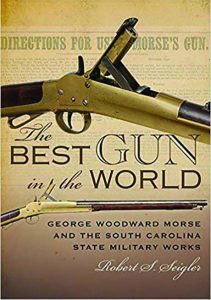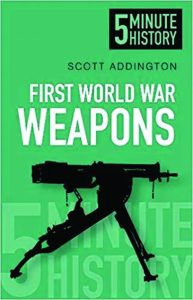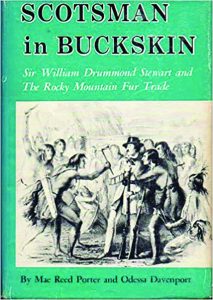Illustrated, detailed reference work on Civil War Morse rifle
Review by Larry S. Sterett | Contributing Editor
 THE BEST GUN IN THE WORLD, by Robert S. Seigler. ©2017. Published by the University of South Carolina Press, Columbia, SC 29208. Price: $49.99, plus shipping. Most bookstores, or Amazon, should have or be able to obtain copies.
THE BEST GUN IN THE WORLD, by Robert S. Seigler. ©2017. Published by the University of South Carolina Press, Columbia, SC 29208. Price: $49.99, plus shipping. Most bookstores, or Amazon, should have or be able to obtain copies.
Sub-titled ‘George Woodward Morse and the South Carolina State Military Works’ this 288-page hardbound volume is a gem of information. In fact, it is the only source of readily available information, of which this reviewer is aware, on a most unusual rifle of the Civil War era.
The first Morse rifle this reviewer ever saw was decades ago in an arms museum somewhere in the East Coast region. The placard with it did not provide much information and he remembers marveling at the amount of brass used in the construction and the unique design of the breech mechanism. This volume provides answers to the unanswered questions of long ago.
Following the acknowledgments and a short, illustrated introduction, this tome features 21 chapters, a conclusion, five appendices, more than twenty pages of notes—chapter by chapter, plus the appendices—a bibliography and an index. (The notes section is extensive. A number of the chapters have more than 40 notes each and Chapter 20 has 95 notes listed. Author Seigler was thorough and did his research well.)
This volume is illustrated with a reasonable number of photographs and drawings, including patent specification drawings. The majority of the photographs are black-and-white period photos, but there is one section of seven pages of color photos; the brass used in the Morse rifle construction is easily noted in the color photos. Some of the drawings are maps showing locations of various buildings, and are relative to the time frame of the Morse rifle project. There are also photos of newspaper articles and of some of Morse’s other projects—he invented cartridges, loading tools, and a number of other ordnance-related items such as an inside lock for percussion-cap arms.
From the exterior, the Morse rifle appears to be a simple design, but the exploded view as shown on page 162 indicates it is really a complex design, with more than 56 parts, including screws, used in its construction. If you are a student or collector of Civil War small arms, museum curator, or just enjoy reading about the arms of that era, this volume is a first class historical reference work and deserves space on your bookshelf. This is the only book devoted to the Morse rifle, and Morse related projects this reviewer has seen. Well researched it is thorough from a technical and historical point of view.
Small book covers the arms used in World War I combat
Review by Larry S, Sterett | Contributing Editor
 FIRST WORLD WAR WEAPONS by Scot Addington. Published by The History Press, Dept. TGM, The Mill, Brimscombe Port, Stroud, Gloucestershire, GL5 2QG, UK. Price: 5 pounds. Available in some bookstores, but may be difficult to find. Try Amazon books.
FIRST WORLD WAR WEAPONS by Scot Addington. Published by The History Press, Dept. TGM, The Mill, Brimscombe Port, Stroud, Gloucestershire, GL5 2QG, UK. Price: 5 pounds. Available in some bookstores, but may be difficult to find. Try Amazon books.
This small quarter-inch thick 128-page softbound book has a sub-title of 5 Minute History on both the front and back covers. Exactly what this means is unclear, as you cannot read the book in five minutes and do it justice, even if you are a speed-reader.
The introduction explains that not every weapon used in WWI is covered, but only those which had the most impact. (Some 35 million casualties were caused, of which an estimated 14 million resulted in death.) Following the introduction this tome is divided into eighteen brief chapters, plus a page-and one-half of notes—really more of a short bibliography.
Beginning with Artillery and finishing with Allied Submarines, the topics covered include Pistols, Machine Guns, Airships, Gas, Grenades, Tanks, and German U-Boats. There are no photographs, but at least one shadow-style outline appears in each three or four-page chapter, plus a sidebar or two related to the topic covered. (The illustrations are not always what they should be. As examples, in the pistol chapter one sidebar is on the Belgian Browning Model 1900 but the illustration appears to be a Colt (Browning design) Model 1911.)
The sidebars are of two types—a brief Did You Know? Consisting of some obscure war-related fact, and I Was There consisting of brief comments by veterans, generally on some unusual event. Both types of sidebars add to the value of this small book. This reviewer was not aware of the majority of the facts presented in the Did You Know?, such as ‘The water blanket (jacket) of the German Maxim heavy machine gun took 7.5 pints of water which was raised to the boiling point after one minute of continuous firing.’ or that there were male and female tanks, or that “The 1st US Light Tank Brigade, commanded by George S. Patton, was made up entirely of Renault (French) FT tanks.”
The I Was There sidebars vary in length from three or four lines to a full page in length and relate to the chapter in which they appear. In the Mines chapter a Corporal Reginald Haine made the comment “I saw the effect of the mines. I saw the crater at La Boisselle. It really petrified me, the size of it. I mean, it was as big as a cathedral.” The largest single mine blast was the Lone Tree which produced a crater over 37 feet deep and more than 230 feet in diameter using 91,000 pounds of ammonal. A multiple blast using over 21 tons of ammonal was set off on 7 June 1917 and killed an estimated 10,000 Germans; the blast was heard in London and other parts of southern England.
This is an interesting pocket-size book on the major world event of 100 years ago. Readers may not agree with some of the author’s comments, such as the chapter on Pistols. It would be better titled Handguns since more countries used revolvers in WWI than they did pistols. As to being a 5 Minute History, five minutes per chapter would be more apt. It is not a reference volume in the usual sense of the term. Still, it’s worth reading and reflecting on the means by which the wartime killing has changed, or not.
Scotch nobleman’s bio captures 19th century American West
Review by Larry S. Sterett | Contributing Editor
 SCOTSMAN IN BUCKSKIN by Mae Reed Porter and Odessa Davenport. ©1963. Published by Hastings House, Publishers, New York, NY and simultaneously in Canada by S.J. Reginald Saunders, Publishers, Toronto, Canada. Available at Amazon in both softbound and hardbound editions for approximately $12.00 to $30.00, plus shipping.
SCOTSMAN IN BUCKSKIN by Mae Reed Porter and Odessa Davenport. ©1963. Published by Hastings House, Publishers, New York, NY and simultaneously in Canada by S.J. Reginald Saunders, Publishers, Toronto, Canada. Available at Amazon in both softbound and hardbound editions for approximately $12.00 to $30.00, plus shipping.
Although this biographical tome was published more than a half-century ago it still is worth reviewing, as it is the only volume of its kind this reviewer has discovered…by accident. Sub-titled Sir William Drummond Steward and the Rocky Mountain Fur Trade, it is the work of two women who spent nearly two dozen years on the project collecting and assembling the material. In addition it required a number of trips to Scotland and elsewhere, including St. Louis and Galveston, to track down bits of information on a Scotsman who seemed larger than life.
This 318-page hardbound volume features 26 chapters, a preface by Odessa Davenport, an Aftermath, two sections—My Path to Sir William and What I Found in Texas—both by Mae Reed Porter, a bibliography, an index and a list of the dozen-plus black-and-white illustrations—many are paintings by Alfred Jacob Miller, retained by Sir William as artist on call. (One non-Miller painting, found in an abandoned church in Scotland, shows William in his full dress uniform, probably when he was a lieutenant in the British Army under Wellington at Waterloo. He retired from the army as a captain on half-pay.)
Born on Dec. 26, 1795, the second son of one of the oldest and wealthiest noble families of Scotland, Sir William died April 28, 1871, the 19th Lord of Grand Tully and the 7th Baronet of Murthly, with three estates totaling more than 32,000 acres and the income therefrom.
His only son, George, born sometime in 1830 to Christina Stewart (no relation), died on Oct. 29, 1868, under mysterious circumstances. (William married Christina, a maid on a neighboring estate, because she had great legs, from the knees down from what he could see as she tromped blankets in a washtub. Her portrait indicates she was also beautiful.) George had risen to the rank of major in the British Army and was one of the 98 soldiers who returned to the British lines after the Charge of the Light Brigade during the Crimean War. (George made the charge both directions and did not receive even a minor wound.) Within an hour afterward some others straggled back, a few with their horses, bringing the total still alive to 276.The charge—going and returning—took 20 minutes to face cannons on the right, cannons, on the left and cannons straight ahead or behind on the return.
Being second son William did not inherit title to the estates when his father died, but received an allowance (?) paid grudgingly and often late by older brother John. Wanting to see the American West, the Rockies, Indians, etc., William caught a sailing ship bound in that direction. The balance of this biographical gem details some of his adventures at the yearly trappers/traders encampments on the Green River, hunting, the people he met—Kit Carson, Jim Bridger, Joe Walker, Black Harris, William H. Gray, and others, including missionaries such as the Whitmans—Narcissa and Marcus—plus hunting adventures with his Manton rifles, and much more. (Imagine shooting a buffalo (bison) bull in the fore-skull with a 12-bore Manton rifle. It dropped him like a rock, but not dead, only stunned with a headache; in a few minutes he gets back on his feet, shakes his head and walks away.
The American Fur Company, the Hudson Bay Company, Fort Laramie, Chimney Rock, Fort Walla Walla, Indians of many tribes—Sioux, Shoshone, Flatheads, Crow, Delaware, Cheyenne, Bannock, etc.-—are covered. Captain Stewart traveled in style when possible, and some of his delicacies were sampled for the first time by trappers and others. (No Scottish meal would be complete without haggis, and while no recipe is provided the basic ingredients are listed; one made using bison meat should be interesting.)
This is one interesting volume on the early American West during the days when the beaver was the king and before the slaughter of the bison for their hides. It is extremely well researched and written, among the best this reviewer has had the opportunity to read. The two women did an excellent job in their presentation of Sir William Stewart and his life. Some publisher needs to reprint it.



